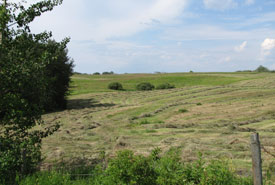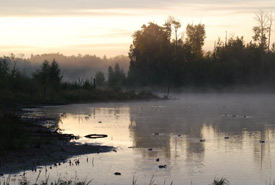The Beaver Hills Moraine: A distinctive Alberta landscape

Human development on the hummocky moraine. (Photo by Beaver Hills Initiative)
The Beaver Hills Initiative (BHI) is made up of a group of more than 30 volunteer partner organizations, including representatives from all three levels of government, the science and academic community, residents, industry and non-government organizations. This group came together in 2002 because it was concerned about the cumulative effects of increased growth and economic activity on the distinctive landscape of the Beaver Hills, located just east of Edmonton in central Alberta.
Beaver Hills forms a distinctive geomorphological feature that covers an area of 1,572 square kilometres, representing an island of the dry mixed wood boreal forest within Alberta’s aspen parkland. Characteristic of this moraine landscape is the hummocky “knob and kettle” terrain of upland forests interspersed with low-lying areas containing natural wetlands and small lakes.
A rich landscape
This diversified landscape supports both boreal forest species (moose, black bear, lynx) and parkland species (sharp-tailed grouse, mule deer) — including up to 48 mammals, 152 birds and eight amphibians and reptiles. Approximately 40 percent of Beaver Hills remains as natural habitat.
Beaver Hills has witnessed a long history of active conservation. Presently a quarter of the region is protected under federal, provincial and/or municipal legislation, including six of Alberta’s Natural Areas. Over the past 13 years, BHI has achieved a number of significant accomplishments through shared initiatives and coordinated action.
Of particular significance has been the development of a Land Management Framework, the drafting of a State of the Beaver Hills Report and the preparation of a Tourism Development Opportunity Assessment for the Beaver Hills. In addition, a stewardship engagement strategy and a public and Aboriginal engagement campaign have provided the framework for an expanded engagement of Aboriginal peoples and local residents. The overall intent of these initiatives is to ensure that the BHI can accommodate and guide change while conserving the ecological values, landscape character and sense of place of the Beaver Hills.
Biosphere Reserve nomination
At the end of May, the BHI submitted a nomination to have Beaver Hills designated as a Biosphere Reserve under the Man and the Biosphere Programme (MAB) of the United Nations Educational, Scientific and Cultural Organization (UNESCO). The BHI believes Beaver Hills is geographically and contextually well placed to encourage innovative approaches to conservation and sustainable development in a manner consistent with the Biosphere Reserve Program.
Biosphere Reserves are the only global designation or accreditation for an area demonstrating excellence in sustainable development at a regional scale. They represent regions that exhibit how society can live and work in harmony with nature.
Biosphere Reserves support three interconnected functions:
- conservation: conserving genetic resources, species, ecosystems, landscapes and cultural heritage;
- development: fostering economic and human development that is socio-culturally and ecologically sustainable; and
- logistic support (capacity building): providing support for applied research, monitoring, education and information exchange.
In order to carry out these three functions, each Biosphere Reserve contains three elements:
- core protected areas: these legislatively protected areas include provincial and national parks that conserve biodiversity and provide research monitoring opportunities in minimally disturbed ecosystems;
- buffer zones: these usually surround or adjoin the core protected areas and emphasize conservation in connection with cooperative activities compatible with sound ecological practices;
- transition areas (areas of cooperation): these generally comprise the largest proportion of a Biosphere Reserve and consist of the lived-in and working landscape, where sustainable economic and human development is demonstrated through the involvement and collaboration of local communities.

Wetland in Beaver Hills, AB (Photo by Beaver Hills Initiative)
In the case of the Beaver Hills Biosphere nomination, Elk Island National Park and Miquelon Lake Provincial Park are the proposed core areas, and the buffer zones include the Ministik Lake Game Bird Sanctuary, the Cooking Lake–Blackfoot Provincial Recreation Area, the Strathcona Wilderness Society and the six Natural Areas. The transition area (the lived-in and working landscape) accounts for almost three-quarters of the proposed Biosphere area.
We are pleased to report that following the submission of the Beaver Hills Biosphere nomination package to the Canadian Commission for UNESCO (CCUNESCO) at the end of May, the nomination was critically reviewed by the Canada Man and Biosphere Committee (MAB) and Canada MAB subsequently recommended to the CCUNESCO that the Beaver Hills Biosphere nomination be accepted for forwarding to UNESCO's International Secretariat in Paris as an approved Canadian candidate area.
The Beaver Hills Biosphere nomination, together with other nominations submitted from around the world, will then be assessed and evaluated by the International Advisory Committee for Biosphere Reserves (IACBR) that comprises 12 internationally recognized scientific and technical experts. That committee will prepare recommendations for all the submitted candidate areas that will eventually be considered by the International Co-ordinating Council for Biosphere Reserves (MAB-ICC) The MAB-ICC meets once a year, normally in Paris in early June, and it is at that meeting the final decision is made on all nominations. Consequently, the BHI will not know until June of 2016 whether or not the Beaver Hills nomination has been successful.
The Beaver Hills Initiative would like to take this opportunity to express its grateful thanks and appreciation to all those who have contributed to and supported the Beaver Hills Biosphere nomination. We will provide relevant updates over the coming year concerning the nomination review process through subsequent BHI newsletters and the BHI website.


